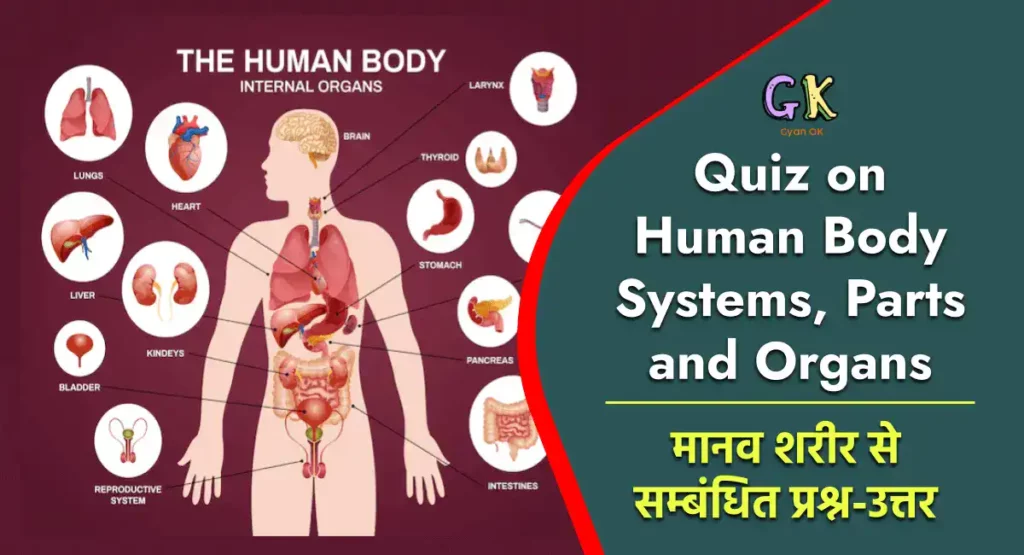The human body is like a giant puzzle, full of amazing pieces that fit together perfectly. It’s really interesting how everything works together to keep us alive and healthy. Our heart beats, our lungs breathe, and our brain thinks – all without us even needing to tell them to! Have you ever wondered how all of this happens? Well, we’ve got something cool for you! We’ve made a quiz that’s all about the human body. It’s a fun way to test what you know and learn even more about how our bodies work. Are you up for the challenge? Give our quiz a try and discover the incredible world inside you!

Quiz on Body Parts, Systems and Organs
Within our bodies, a series of remarkable processes unfold constantly. Consider your heart, a powerful pump that propels blood through intricate pathways known as veins and arteries. These pathways facilitate the distribution of crucial elements like oxygen and nutrients to all parts of the body. Interestingly, bones possess a dynamic nature; they grow and adapt, similar to how buildings might undergo construction and repairs.
Let’s now focus on muscles, which operate collectively, enabling basic actions such as jumping, running, and playing. The brain, on the other hand, functions as a sophisticated computer. It manages cognitive processes, memory retention, and even the occurrence of dreams. The stomach serves as a vital processor; it breaks down food into smaller components for the body to utilize. Notably, the skin functions as a protective barrier, guarding against harmful agents while allowing for tactile sensations, such as a gentle breeze.
Our bodies can be likened to comprehensive volumes that narrate stories involving bones, blood, and even simple actions like blinking. It’s truly remarkable how each piece fits seamlessly into a larger puzzle. As we acquire knowledge, we gradually realize the remarkable complexity of our body’s machinery, ceaselessly operating to sustain our daily existence.
Following we have given mcqs on the topic “Human body parts, system and organs” for your self-assessment and to help you learn something new through this activity.
1. What is the name of the biggest part of the human brain?
a) Cerebellum
b) Medulla
c) Cerebrum
d) Thalamus
- Correct Answer: c) Cerebrum
2. The colored part of the human eye that controls how much light passes through the pupil is called the?
a) Pupil
b) Retina
c) Cornea
d) Iris
- Correct Answer: d) Iris
3. What is the name of the substance that gives skin and hair its pigment?
a) Melatonin
b) Melanin
c) Collagen
d) Keratin
- Correct Answer: b) Melanin
4. The muscles found in the front of your thighs are known as what?
a) Hamstrings
b) Biceps
c) Quadriceps
d) Triceps
- Correct Answer: c) Quadriceps
5. True or false? The two chambers at the bottom of your heart are called ventricles.
a) True
b) False
- Correct Answer: a) True
6. What substance are nails made of?
a) Collagen
b) Enamel
c) Keratin
d) Melanin
- Correct Answer: c) Keratin
7. What is the human body’s biggest organ?
a) Heart
b) Liver
c) Brain
d) Skin
- Correct Answer: d) Skin
8. The innermost part of bones contains what?
a) Blood vessels
b) Nerves
c) Bone marrow
d) Cartilage
- Correct Answer: c) Bone marrow
9. True or false? An adult human body has over 500 bones.
a) True
b) False
- Correct Answer: b) False (there are 206)
10. How many lungs does the human body have?
a) 1
b) 2
c) 3
d) 4
– Correct Answer: b) 2
11. Another name for your voice box is the?
a) Trachea
b) Larynx
c) Bronchus
d) Pharynx
– Correct Answer: b) Larynx
12. The two holes in your nose are called?
a) Alveoli
b) Bronchi
c) Nostrils
d) Sinuses
– Correct Answer: c) Nostrils
13. Your tongue is home to special structures that allow you to experience tastes such as sour, sweet, bitter, and salty, what is their name?
a) Taste receptors
b) Olfactory bulbs
c) Nociceptors
d) Taste buds
– Correct Answer: d) Taste buds
14. The bones that make up your spine are called what?
a) Ribs
b) Clavicles
c) Vertebrae
d) Femurs
– Correct Answer: c) Vertebrae
15. The shape of DNA is known as?
a) Helix
b) Spiral
c) Double strand
d) Amino acid chain
– Correct Answer: a) Helix
16. The flow of blood through your heart and around your body is called?
a) Respiration
b) Digestion
c) Circulation
d) Metabolism
– Correct Answer: c) Circulation
17. The bones around your chest that protect organs such as the heart are called what?
a) Humerus
b) Ribs
c) Fibula
d) Radius
– Correct Answer: b) Ribs
18. What is the name of the long pipe that shifts food from the back of your throat down to your stomach?
a) Trachea
b) Ureter
c) Esophagus
d) Bronchus
– Correct Answer: c) Esophagus
19. True or false? Your ears are important when it comes to staying balanced.
a) True
b) False
– Correct Answer: a) True
20. The outside layer of skin on the human body is called the?
a) Dermis
b) Epidermis
c) Hypodermis
d) Subcutis
– Correct Answer: b) Epidermis





